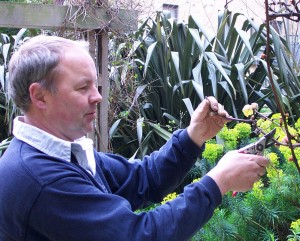As the weather improves this week, the temperature climbs and we all begin to look outside again. At this time of year, I frequently go into the garden and think ‘what a tip!’ All those odds and ends, badly coiled hoses, un-pruned plants, and scrappy undergrowth – how could I have not noticed it before? It is true that without the kind veil of foliage, gardens can look particularly grim at this time of year. If all this is familiar to you, then cheer yourself up by leafing through magazines and books with their summery pictures of tranquillity that we all associate with gardens. Perhaps it is finally all too much? Maybe it is time to start again? After all if you’re not going to move house you might as well sort the garden out.
But where to start? Most people really struggle when it comes to writing a coherent brief for a designer. As they are unfamiliar with the process of design, or what a designer might propose, they feel intimidated by the whole procedure. If you’re thinking of making changes in your own garden or have a new project, why not start by tagging images that you like, even if they are wildly diverse. This will help to get you thinking in order that you can write a simple brief. Start with a few simple bullet points:
- When you are there: do you look at the garden all day or only evenings/weekends? Is it a second home, perhaps used seasonally?
- Think how you will use the garden: do you entertain? Do you have children, pets?
- Are you a keen gardener? In all honesty, how much time are you likely to spend out there? If you haven’t shown much interest so far, then don’t lumber yourself with a high maintenance scheme with lots of herbaceous plants – leave that to the National Trust! If you are keen, perhaps you might consider an area for vegetables or fruit.
- Instead of using clichéd phrases like ‘year-round colour’ or ‘lots of evergreens’, try instead to think in terms of how the garden will look and feel. Maybe you like things wild and romantic – scrambling roses, long grass with wild flowers, apple trees laden with fruit. Or perhaps you are more controlled – clean swept paving, topiary, clipped hedges, splashes of colour or white flowers kept to occasional containers. If there is a particular style or image that sums it up – cottage garden, Mediterranean, urban chic, or family friendly, then add to your brief.
- Are there any particular features that you want in the garden hot tub, fire pit, water feature, swimming pool?
- If there are any facts that the garden designer might not know at a quick visit – tell them – like: ‘It’s always sunny just here late in the morning’, or ‘I’ve never liked that house next door can we screen it’. Other than that, try not to lead your designer too much – no ‘I’ve always fancied a circular lawn’ or ‘I just thought a raised bed here would be nice’. Let them come up with the ideas – you will be pleasantly surprised!
- Finally – BUDGET! Always a tricky one! In my experience most clients say that they don’t have a budget in mind or that they have no idea. In practice, everybody has some idea and most clients actually do have a budget in mind. It is supremely unhelpful if you don’t share your thoughts on what you want to spend with your designer. You would walk into an estate agent and say you had no idea of budget. In the end, the more detail you can give a designer on cost, the less of everybody’s time is wasted. This is especially important if you have an over-riding cost limit – you only want to spend the £40K granny left you and not a penny more. And do be clear whether you are talking VAT inclusive or excluding VAT.
Presumably, if you have come as far as reading this blog, you are interested in employing a garden designer, either now or in the future. if you want to compare people, do try and start with suitably qualified and professional designers. Of course it goes without saying that B&W are the best, but if you want a comparison, go to the Society of Garden Designers website (www.SGD.org.uk) and look through a few designers in your area.
John Wyer




